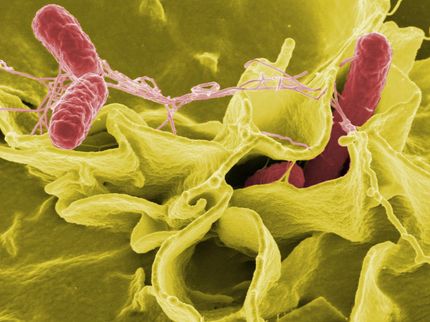Fighting fire blight and detecting Salmonella
ETH researchers have created an effective weapon against the plant disease fire blight and a new method for detection of Salmonella. Both are based on particular viruses that attack only one species of bacteria.
The plant disease fire blight, caused by the bacterium Erwinia amylovora, is dreaded by fruit growers. It affects apple and pear trees and other plants in the rosacea family, and if a tree becomes affected it usually has to be cleared and burned.
The pathogen that causes fire blight is difficult to control. In exceptional cases, farmers can use the antibiotic streptomycin, but even this cannot prevent the pathogen from disseminating via pollinating insects.
Use the enemy’s enemy
A new control strategy has now been presented by researchers led by ETH professor Martin Loessner: they employed a bacterial virus (bacteriophage) designated Y2 that exclusively infects the fire blight pathogen, and equipped it with additional genes. This allowed them to create a highly effective and specific weapon against the Erwinia bacterium.
The native form of Y2 is a natural Erwinia killer, but it is unable to adequately penetrate the thick slime layer that protects the bacterium. Infact, this carbohydrate slime is very tough and clogs the vascular system of plants, causing the flowers and leaves to wither.
Yet, this does not prevent another bacteriophage, named L1, to attack Erwinia. This virus features particular enzymes which can dissolve the mucus efficiently. However, it is not as effective in killing the fire blight pathogen.
Equipping Y2 with mucus-dissolving abilities
By incorporating the gene for this enzyme from L1 into the Y2 phage, the researchers created a genetically modified variant combining the properties of both: it is is able to dissolve its mucus layer efficiently, and highly infective and lethal to the Erwinia bacterium.
Erwinia amylovora infects host plants by entering via blossoms during the flowering period. After infection, the flower stalks blacken, and ooze drops appear on the leaf stems. (Photo: Agroscope).
As soon as Y2 enters the bacterium, it starts to proliferate on a massive scale. It dissolves the bacterium from the inside out, freeing itself to attack further bacteria. Thus, mucus-dissolving enzymes enter the environment in large quantities, which accelerates the degradation of the mucus layer on further bacteria and thus facilitates their infection. The destructive process then progresses rapidly.
“The optimized bacteriophage proved to be very effective against the fire blight pathogen, not only in the laboratory but also in infected apple blossoms,” says Loessner. The tests were conducted with infected plant material in safety-level greenhouses.., Field tests have not been carried out: “Fire blight is one of the worst plant diseases; you cannot experiment in the field,” Loessner emphasises.
Turn a virus into a sensor
The researchers not only created a bacterial killer, they also used another gene to produce a second Y2 variant that helps to detect the fire blight pathogen. The gene ensures that the bacteria begin to light up when infected by the bacteriophages. This light can be measured easily and used for specific detection of the pathogen.
This method is not only fast and reliable, it is also very sensitive: “With the help of our sensor phages, a few thousand infected bacteria are sufficient to directly detect fire blight,” says Loessner. Previous detection methods were much slower, less sensitive and occasionally providing false results. Because the Y2 sensor phage infects only Erwinia, this is not the case with the new assay. High specificity as the basis for Salmonella detection
The tail fiber of the bacteriophage S16 (red frame) was reproduced to develop a universal detection method for Salmonella. (Graphics: ETH Zurich)
Loessner and his colleagues also made use of the fact that bacteriophages are generally very host-specific in another way: to detect Salmonella. In a second paper, also published in the journal Applied and Environmental Microbiology, they showed how they used synthetically produced bacteriophage components to develop a universal detection method for Salmonella. It means that all 2,500 known sub-types can be detected; previous methods based on antibodies recognised only a fraction of these variants and were also slower.
Loessner’s team reproduced a particular component of the Salmonella-specific bacteriophage S16. This component – a virus tail fibre – features a spherical terminal binding protein that can adhere to two specific surface structures of all Salmonella types. The artificial tail fibre, along with the recognition structure, has been attached to the surface of microscopically small magnetic beads.
This allows almost any fluids and samples to be tested for the presence and quantity of Salmonella. As soon as the bacteria binds to the fibres on the magnetic beads, a kind of rusty aggregate forms in the test container, which can be separated easily using an external magnet.
Other news from the department science
Most read news
More news from our other portals
See the theme worlds for related content
Topic world Food safety
Food safety is at the heart of the food and beverage industry. It ensures that the food we eat every day is not only nutritious, but also free of harmful contaminants. From field to plate, the industry monitors and regulates every step of the process with strict quality controls, advanced testing methods and continuous research.

Topic world Food safety
Food safety is at the heart of the food and beverage industry. It ensures that the food we eat every day is not only nutritious, but also free of harmful contaminants. From field to plate, the industry monitors and regulates every step of the process with strict quality controls, advanced testing methods and continuous research.





























































